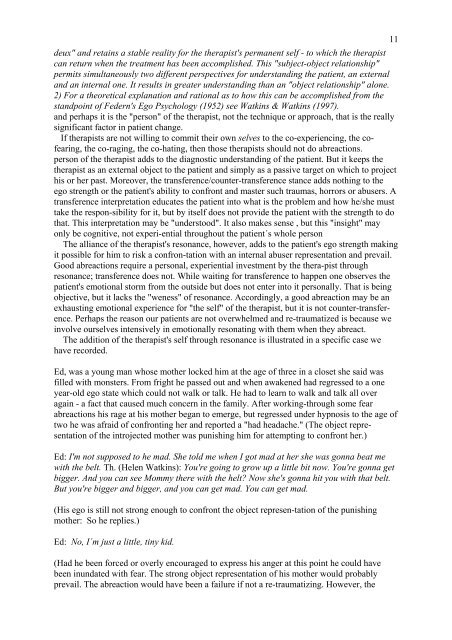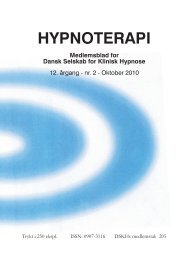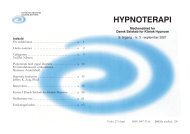HYPNOTERAPl - Dansk Selskab for Klinisk Hypnose
HYPNOTERAPl - Dansk Selskab for Klinisk Hypnose
HYPNOTERAPl - Dansk Selskab for Klinisk Hypnose
Create successful ePaper yourself
Turn your PDF publications into a flip-book with our unique Google optimized e-Paper software.
deux" and retains a stable reality <strong>for</strong> the therapist's permanent self - to which the therapist<br />
can return when the treatment has been accomplished. This "subject-object relationship"<br />
permits simultaneously two different perspectives <strong>for</strong> understanding the patient, an external<br />
and an internal one. It results in greater understanding than an "object relationship" alone.<br />
2) For a theoretical explanation and rational as to how this can be accomplished from the<br />
standpoint of Federn's Ego Psychology (1952) see Watkins & Watkins (1997).<br />
and perhaps it is the "person" of the therapist, not the technique or approach, that is the really<br />
significant factor in patient change.<br />
If therapists are not willing to commit their own selves to the co-experiencing, the cofearing,<br />
the co-raging, the co-hating, then those therapists should not do abreactions.<br />
person of the therapist adds to the diagnostic understanding of the patient. But it keeps the<br />
therapist as an external object to the patient and simply as a passive target on which to project<br />
his or her past. Moreover, the transference/counter-transference stance adds nothing to the<br />
ego strength or the patient's ability to confront and master such traumas, horrors or abusers. A<br />
transference interpretation educates the patient into what is the problem and how he/she must<br />
take the respon-sibility <strong>for</strong> it, but by itself does not provide the patient with the strength to do<br />
that. This interpretation may be "understood". It also makes sense , but this "insight" may<br />
only be cognitive, not experi-ential throughout the patient´s whole person<br />
The alliance of the therapist's resonance, however, adds to the patient's ego strength making<br />
it possible <strong>for</strong> him to risk a confron-tation with an internal abuser representation and prevail.<br />
Good abreactions require a personal, experiential investment by the thera-pist through<br />
resonance; transference does not. While waiting <strong>for</strong> transference to happen one observes the<br />
patient's emotional storm from the outside but does not enter into it personally. That is being<br />
objective, but it lacks the "weness" of resonance. Accordingly, a good abreaction may be an<br />
exhausting emotional experience <strong>for</strong> "the self" of the therapist, but it is not counter-transference.<br />
Perhaps the reason our patients are not overwhelmed and re-traumatized is because we<br />
involve ourselves intensively in emotionally resonating with them when they abreact.<br />
The addition of the therapist's self through resonance is illustrated in a specific case we<br />
have recorded.<br />
Ed, was a young man whose mother locked him at the age of three in a closet she said was<br />
filled with monsters. From fright he passed out and when awakened had regressed to a one<br />
year-old ego state which could not walk or talk. He had to learn to walk and talk all over<br />
again - a fact that caused much concern in the family. After working-through some fear<br />
abreactions his rage at his mother began to emerge, but regressed under hypnosis to the age of<br />
two he was afraid of confronting her and reported a "had headache." (The object representation<br />
of the introjected mother was punishing him <strong>for</strong> attempting to confront her.)<br />
Ed: I'm not supposed to he mad. She told me when I got mad at her she was gonna beat me<br />
with the belt. Th. (Helen Watkins): You're going to grow up a little bit now. You're gonna get<br />
bigger. And you can see Mommy there with the helt? Now she's gonna hit you with that belt.<br />
But you're bigger and bigger, and you can get mad. You can get mad.<br />
(His ego is still not strong enough to confront the object represen-tation of the punishing<br />
mother: So he replies.)<br />
Ed: No, I´m just a little, tiny kid.<br />
(Had he been <strong>for</strong>ced or overly encouraged to express his anger at this point he could have<br />
been inundated with fear. The strong object representation of his mother would probably<br />
prevail. The abreaction would have been a failure if not a re-traumatizing. However, the<br />
11














